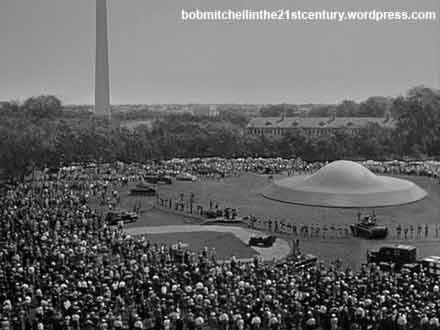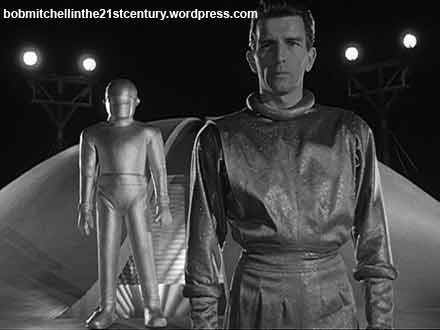
|
|
The Day the Earth Stood Still1951. Twentieth Century-Fox Film Corporation. Directed By Robert Wise. Screenplay By Edmund H. North from the story written by Harry Bates. With Michael Rennie, Patricia Neal and Hugh Marlowe. An unidentified flying object lands in Washington, D.C., carrying an alien and a robot from another planet. The alien, named Klaatu, brings with him an important message to the whole of the earth. He finds out, however, that gathering representatives of every nation is not that easy. Having been locked inside Walter Reed Hospital, he escapes to investigate the reason for the human nature, which he finds "strange." He experiences first hand how it is to live in the human world by introducing himself as Mr. Carpenter and boarding in a family's home. 
The Day the Earth Stood Still, as a science-fiction picture, contains the typical elements of the genre - a space ship landing on the earth, an alien coming out of it, a giant robot with a laser beam, and a scientist. It even has what we may call a scientific plot, in the sense that it is one that follows the scientific method of determining the problem, gathering data, finding solutions, and getting it solved. Scrutinizing the plot in the character of Klaatu, his problem is how to reach out to the representatives of all nations in order that his message to known by the whole of the earth. Seeing no way through United States' authorities, he manages to escape from the authorities and away from the hospital and decides to investigate what he describes as "strange" nature of humans. He does this by living with them in their way of life. On his very first day with the Hensons, when he takes Bobby out, he gets to know that there is a scientist who can help him in his cause - Professor Bernhardt. After impressing the professor with his (Klaatu's) correcting Prof. Bernhardt's solutions on the board, he manages to talk to the professor and devices with him a plan. The plan does not turn out so well, but still ends fine. Thus, with his brilliance, and with the help of the people who believe in him, Klaatu gets through the problem. 
The horror in this film is that it poses a conflict between humanity and the unknown - in this case, an alien and his robot. Especially in the first parts of the film, the terrifying sounds whenever the frames show the spaceship, Klaatu and Gort make us horrified of the fact that a UFO has just landed on earth. In the first place, its plot - the thought that there is indeed other life form in another planet, with more advanced intelligence and technology than ours, and the thought that, as Klaatu points out, they have been monitoring our broadcasts and checking on us – gives chills to the viewers and makes us ask if this is possible. When Klaatu escapes from the hospital, thus, be at large, and manages to disguise himself as a human, his dark silhouette before he introduces himself as Mr. Carpenter accentuates the mysterious being in Klaatu. The terrifying question is: Is Klaatu a menace, or a newfound friend? 
Throughout the film, however, we feel sympathy towards Klaatu. First of all, we find Klaatu not very different from us. Although he comes from another planet, he looks exactly like earth people, he knows how to speak in English, and he perfectly knows how to act like a real and ordinary human as he incorporates himself into the world of humans, using the name Mr. Carpenter. On top of this, we see in him qualities that make him more "humane" than a real human. He speaks what's on his mind very openly. In a way, his dishonesty in hiding his identity at first becomes understandable. In the long run, people who get to know him learn to like him. Bobby regards him as his (Bobby's) best friend. Helen trusts him (Klaatu) when he volunteers looking over her son. After learning the truth about Klaatu and his mission, Helen goes to his side and helps him. It is not Klaatu's anonymity that is terrifying. What the people must realize, however, is that the menace they must avoid is within the earth, and not from outside. Klaatu questions human nature. He cannot fathom what is with humans and with their environment that makes them strange. He does not understand why peace cannot be promoted on this planet. As a point to be taken, the year was released in 1951 - just some years after World War II, when there were atomic bombings, and a year when Cold War was currently being waged. During Cold War, there was a race in nuclear arms between the United States and the Soviet Union, and the allies of both sides. The film, as a science fiction, has in it a social commentary on humanity and their activities. With science, particularly the science in weaponry and nuclear radiation, violence and aggression among the people are reinforced that may lead to the earth's destruction. "By threatening danger, your planet faces danger," Klaatu warns. If human aggression posed a threat to the universe, Klaatu must take an action by annihilating the earth if necessary. With this warning, Klaatu actually shows a Christ-like, messianic role in his coming to the earth. He comes to the world, delivering a message about the end of the world, if such aggression is to persist. People, not listening to him, misunderstand him. After getting killed, he is taken back to life and acquires a heroic image after making himself heard. At last, he gets to pronounce his message. The message he carries: Live in peace. |
| © 2009 Kris Rajani Nagera |